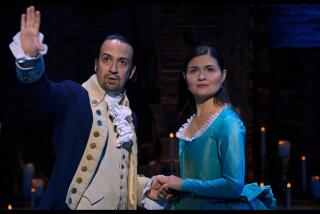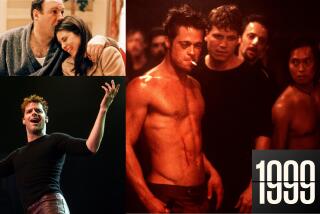‘Measured Century’ Offers a Retrospective That Counts
NEW YORK — The “end-of-the-century” television retrospectives started almost two years ago, in the lead up to New Year’s Eve 1999, but PBS has found room for one more, tonight’s “The First Measured Century.”
The three-hour special stands apart in many ways from the other programs riding on the hoopla of the occasion. Most of the specials that took over the airwaves last year tended to look at the time period through its monumental anecdotes: Lindbergh crossing the Atlantic; the rise of Hitler’s Germany; the Vietnam War; Watergate. Ben Wattenberg, host of “The First Measured Century,” (as well as moderator of PBS’ weekly “Think Tank” and a senior fellow at the American Enterprise Institute) suggests another approach: that of data and statistics.
The last 100 years were marked by a dramatic rise in social science, which offers a different way of telling the country’s story, by looking at such factors as immigration, life expectancy, religion and income, which allow “you and me and the guy behind the counter” to enter the picture, he says.
The program looks at how the influence of statistics has affected the country, in the interrelation between the data and public policy. At the same time, it tells a story of how America has changed, as told through the numbers. Some statistics were gathered specifically for the program and companion book: in particular, the team revisited Muncie, Ind., already perhaps the most-measured city in America, as the site of the “Middletown” studies of 1924 and 1977.
Wattenberg’s conclusion from all the number-crunching: “If you look at the 20th century through a data lens, America is not only the most successful country, but it is successful in many respects that are quite different from other countries.”
His approach couldn’t be more timely, coming off the finally concluded presidential election, which drew much of its initial drama from the election night foul-ups of the major television networks. The networks all relied on exit polling data for their now-notorious botched projections of a winner. The program looks back to the origins and establishment of such polling, and George Gallup’s 1936 wager, a successful one, that he could pick the winner of that year’s presidential contest using just a small representative sample, shaming the pollsters who relied on asking millions of people--an upscale, atypical group drawn from driver’s license and phone records--for whom they planned to vote.
Wattenberg, who was highly critical of the network rush to judgment in a recent newspaper column (He wrote: “They should now be slapped across the wrist by the Feds, perhaps with a machete”), now has a chance to get a close, practical look at the result of what Gallup wrought: He is serving on a panel of outsiders engaged by CNN to evaluate what went wrong on election night. He calls television’s hurry to project a winner before all the polls close “irresponsible,” adding that “in my judgment, they have no damn business screwing around with a federal election.” But he says he is “still trying to keep an open mind” as the CNN investigation proceeds.
It’s not the existence of the polling data that is problematic, Wattenberg argues, but how the numbers are used. The information is valuable, but the networks and the public “can wait three hours,” he says.
The data aren’t necessarily so benign with earlier episodes of data-gathering now discredited as scientific racism explored in “First Measured Century,” including: the use of culturally rigged IQ tests and measurement of head shapes to develop a body of “evidence” used to discriminate against the waves of immigrants entering the country from southern and eastern Europe. But there are also tales of how social science was put to use to reduce such factors as infant mortality in the cities at the beginning of the century, and a look at the public policy implications of Daniel Patrick Moynihan’s controversial mid-1960s study on the breakdown of the black family.
This constant measurement that has marked the century, starting with the most-extensive-ever U.S. Census of 1890, which asked about 250 questions, is still “the best game in town,” Wattenberg argues, praising “the imperfect method of accountability inherent in the great data-gathering machine” that exists today.
“That’s not to say there are not a lot of people working agendas through the data,” he says. But with the companion book of annotated charts (“The First Measured Century: An Illustrated Guide to Trends in America, 1900-2000” by Theodore Caplow, Louis Hicks and Wattenberg) and a Web site (https://www.pbs.org/fmc), Wattenberg wants viewers to look at the data themselves and draw their own conclusions. “You too can be an expert,” he says.
* “The First Measured Century” can be seen tonight at 8:30 on KVCR-TV, and at 9 on KCET-TV. The network has rated it TV-G (suitable for all ages).
More to Read
The complete guide to home viewing
Get Screen Gab for everything about the TV shows and streaming movies everyone’s talking about.
You may occasionally receive promotional content from the Los Angeles Times.






